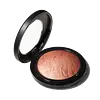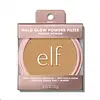What's inside
What's inside
 Key Ingredients
Key Ingredients

 Benefits
Benefits

 Concerns
Concerns

 Ingredients Side-by-side
Ingredients Side-by-side

Mica
Cosmetic ColorantTalc
AbrasiveNylon-12
Dimethicone
EmollientIsopropyl Palmitate
EmollientTocopheryl Acetate
AntioxidantSimmondsia Chinensis Seed Oil
EmollientYeast Extract
Skin ConditioningLauroyl Lysine
Skin ConditioningIsohexadecane
EmollientCetearyl Ethylhexanoate
EmollientGlyceryl Ethylhexanoate/Stearate/Adipate
EmollientZea Mays Starch
AbsorbentMagnesium Aluminum Silicate
AbsorbentEthylhexyl Methoxycinnamate
UV AbsorberPolysorbate 20
EmulsifyingPolysorbate 80
EmulsifyingAcrylamide/Sodium Acryloyldimethyltaurate Copolymer
Emulsion StabilisingCalcium Sodium Borosilicate
Calcium Aluminum Borosilicate
Synthetic Fluorphlogopite
Tin Oxide
AbrasiveSilica
AbrasiveSorbitan Stearate
EmulsifyingOctyldodecyl Stearoyl Stearate
EmollientPhenoxyethanol
PreservativeSodium Dehydroacetate
PreservativeCI 77891
Cosmetic ColorantCI 77491
Cosmetic ColorantCI 77492
Cosmetic ColorantCI 77499
Cosmetic ColorantCI 77000
Cosmetic ColorantCI 77163
Cosmetic ColorantCI 42090
Cosmetic ColorantCI 77400
Cosmetic ColorantCI 75470
Cosmetic ColorantCI 77289
Cosmetic ColorantCI 77288
Cosmetic ColorantCI 77510
Cosmetic ColorantCI 77742
Cosmetic ColorantCI 15850
Cosmetic ColorantCI 77007
Cosmetic ColorantCI 19140
Cosmetic ColorantCI 15985
Cosmetic ColorantMica, Talc, Nylon-12, Dimethicone, Isopropyl Palmitate, Tocopheryl Acetate, Simmondsia Chinensis Seed Oil, Yeast Extract, Lauroyl Lysine, Isohexadecane, Cetearyl Ethylhexanoate, Glyceryl Ethylhexanoate/Stearate/Adipate, Zea Mays Starch, Magnesium Aluminum Silicate, Ethylhexyl Methoxycinnamate, Polysorbate 20, Polysorbate 80, Acrylamide/Sodium Acryloyldimethyltaurate Copolymer, Calcium Sodium Borosilicate, Calcium Aluminum Borosilicate, Synthetic Fluorphlogopite, Tin Oxide, Silica, Sorbitan Stearate, Octyldodecyl Stearoyl Stearate, Phenoxyethanol, Sodium Dehydroacetate, CI 77891, CI 77491, CI 77492, CI 77499, CI 77000, CI 77163, CI 42090, CI 77400, CI 75470, CI 77289, CI 77288, CI 77510, CI 77742, CI 15850, CI 77007, CI 19140, CI 15985
Synthetic Fluorphlogopite
Silica
AbrasiveDimethicone
EmollientPolymethylsilsesquioxane
Boron Nitride
AbsorbentZinc Stearate
Cosmetic ColorantZinc Palmitate
Octyldodecyl Stearoyl Stearate
EmollientTriethoxycaprylylsilane
Diisostearyl Malate
EmollientIsoamyl Laurate
EmollientAluminum Starch Octenylsuccinate
AbsorbentPhenoxyethanol
PreservativeCaprylyl Glycol
EmollientSynthetic Sapphire
Squalane
EmollientTin Oxide
AbrasiveHydrolyzed Sodium Hyaluronate
Skin ConditioningCI 77492
Cosmetic ColorantTitanium Dioxide
Cosmetic ColorantCI 77163
Cosmetic ColorantCI 77491
Cosmetic ColorantCI 77499
Cosmetic ColorantSynthetic Fluorphlogopite, Silica, Dimethicone, Polymethylsilsesquioxane, Boron Nitride, Zinc Stearate, Zinc Palmitate, Octyldodecyl Stearoyl Stearate, Triethoxycaprylylsilane, Diisostearyl Malate, Isoamyl Laurate, Aluminum Starch Octenylsuccinate, Phenoxyethanol, Caprylyl Glycol, Synthetic Sapphire, Squalane, Tin Oxide, Hydrolyzed Sodium Hyaluronate, CI 77492, Titanium Dioxide, CI 77163, CI 77491, CI 77499
 Reviews
Reviews

Ingredients Explained
These ingredients are found in both products.
Ingredients higher up in an ingredient list are typically present in a larger amount.
This synthetic powder is used to add a pearly/white color in cosmetics.
Ci 77491 is also hydrated iron III oxide. It's sole purpose is to give a red/pink hue to products.
Iron III oxides are classified as inorganic chemicals for coloring.
Synthetically created Ci 77491 is considered safer than those naturally found. This is because the synthetically created version may contain less impurities. Iron oxides are generally non-toxic and non-allergenic.
Learn more about CI 77491Ci 77492 is also hydrated iron III oxide. It's sole purpose is to give a yellow hue to products.
Iron III oxides are classified as inorganic chemicals for coloring.
Synthetically created Ci 77492 is considered safer than those naturally found. This is because the synthetically created version may contain less impurities. Iron oxides are generally non-toxic and non-allergenic.
Learn more about CI 77492Ci 77499 is also hydrated iron III oxide. It is created from mixing red and black iron oxides. This helps give shades of darkness to a product.
Iron III oxides are classified as inorganic chemicals for coloring.
Dimethicone is a type of synthetic silicone created from natural materials such as quartz.
What it does:
Dimethicone comes in different viscosities:
Depending on the viscosity, dimethicone has different properties.
Ingredients lists don't always show which type is used, so we recommend reaching out to the brand if you have questions about the viscosity.
This ingredient is unlikely to cause irritation because it does not get absorbed into skin. However, people with silicone allergies should be careful about using this ingredient.
Note: Dimethicone may contribute to pilling. This is because it is not oil or water soluble, so pilling may occur when layered with products. When mixed with heavy oils in a formula, the outcome is also quite greasy.
Learn more about DimethiconeOctyldodecyl Stearoyl Stearate is created from stearic acid.
It is an emollient and thickens the lipid (oil) portion of a product. Due to its emollient properties, it may not be fungal-acne safe.
Phenoxyethanol is a preservative that has germicide, antimicrobial, and aromatic properties. Studies show that phenoxyethanol can prevent microbial growth. By itself, it has a scent that is similar to that of a rose.
It's often used in formulations along with Caprylyl Glycol to preserve the shelf life of products.
Silica, also known as silicon dioxide, is a naturally occurring mineral. It is used as a fine, spherical, and porous powder in cosmetics.
Though it has exfoliant properties, the function of silica varies depending on the product.
The unique structure of silica enhances the spreadability and adds smoothness, making it a great texture enhancer.
It is also used as an active carrier, emulsifier, and mattifier due to its ability to absorb excess oil.
In some products, tiny microneedles called spicules are made from silica or hydrolyzed sponge. When you rub them in, they lightly polish away dead skin layers and enhance the penetration of active ingredients.
Learn more about SilicaSynthetic Fluorphlogopite is the synthethic version of mica. It consists of fluorine, aluminum and silicate.
Synthetic Fluorphlogopite is used to add volume to products.
It is considered non-irritating on the skin.
Learn more about Synthetic FluorphlogopiteTin Oxide is an inorganic oxide used to add opacity and volume to a product. In nature, it is already found in mineral form. The main ore of tin is an opaque and shiny mineral called casseterite.
Tin Oxide helps remove translucency in a product, or make it more opaque. Besides adding opacity, tin oxide is used for bulking to add volume.